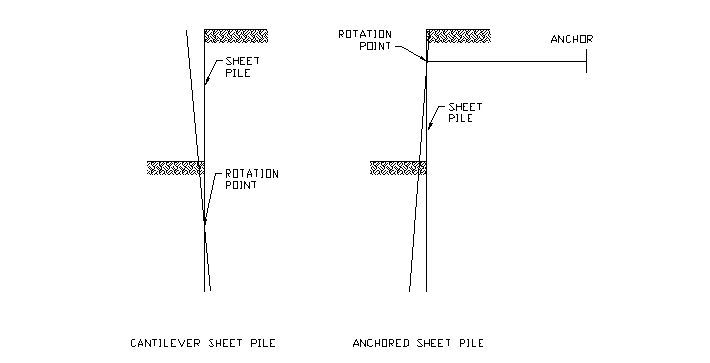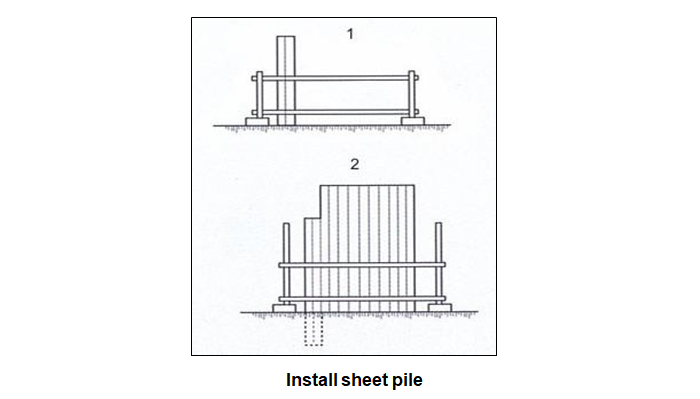The installation of sheet piles are the famous type of temporary works for the construction of building or bridge during foundation works such as pilecap structural.
Steel sheet piles are long structural sections with a vertical interlocking system that creates a continuous wall.
The walls are most often used to retain either soil or water.
Ability of a sheet pile section to perform is dependent upon its geometry and the soils it is driven into.
The sheet piling transfers pressure from the high side of the wall to the soil in front of the wall.
There are permanent and temporary applications. Permanent sheet piles remain in the ground and serve as permanent retaining structures. Temporary sheet piles are designed to provide safe access for construction, and are then removed.
Sheet piling design must account for earth, water, and adjacent structures. Sheet pile design can be straightforward in simple cases, and quite complex in some other conditions.
Typically, there are two systems in sheet pile wall that must be designed:
Cantilever Sheet Piles: the sheet pile wall that retains the earth and water ( etc.), Design of cantilever sheet pile wall includes two parts:
- Design the embed length of sheet pile against rotational failure.
- Select the sheet pile section to resist moment and shear.
Anchored Sheet Piles: the Support System (i.e. the internal or external bracing such as rakers, struts, or tiebacks) that supports the sheet pile wall.
Commonly assumed failure mode of cantilever and anchored sheet piles are shown below:

Method Statement for Sheet Piling
This method statement describes the method and procedures involved in the installation of sheet pile wall (refer to approved drawings) as temporary shoring and facilitate the work relating to the construction of the proposed building or structure.
The sheet pile is a U Section and will be installed by means of a Vibro Hammer.
As the pile comes in 12 meter or shorter lengths, welding will be used to join the sheet piles if a longer length is required.
On the other hand, Oxy-acetylene will be used to cut the sheet piles if these protrude out and causes a danger to the trains passage.
The sheet piles used will be the type of FSP Type III (British Standard).
IWF Beams: Two I-Beams, will be used as a temporary guide for initial start of sheet pile installation.
Necessary Equipment / Tools
- Truck crane (minimum 20 M ton)
- 3 – 7 tons Hydraulic vibro-hammer c/w power pack (depending on site conditions)
- Welding set
- Back Hoe (if required)
Sequence of Work
These preparation works proceed both piling and staging activities. The site shall be levelled to allow safe operation of heavy machinery.
Steel plates will be provided at locations where the ground is soft and unable to support the machinery.
Fabrication and stocking of material such as sheet piles and other work related material will be within the right of way. Exact location will be subject to site constraints.
Gas palettes and welding machines will be located close to the place of work.
Before starting the installation of sheet piles, the location and grid line need to be prepared to control the straightness and verticality on the position.
The sheet piles will be installed between two guides of I-beam and a short temporary sheet pile location as a guide to install the sheet pile.
Temporary short sheet pile to be used as initial guide, when starting the sheet piling installation.
A vibro-hammer suspended with a crawler crane will vibrate the piles to the required depth.
The following sequence will be used during sheet pile installation:
Surveyor locates centre of sheet pile wall.
Appropriate reference line and offset point to the centre of piles to be set out.
Arrange the piles at each point with the use of a timber frame to ease and maximize installation.
Use vibro-hammer to install piles, a level may be used in checking the verticality of the sheet pile wall.
Two I-Beams will be used to guide and correct the pile verticality and position.
Piling will continue until the desired depth is attained.
Repeat above steps for the next sheet pile and for every new sheet pile wall.
Length of Sheet Pile
Sheet piles will be delivered in 12m or shorter lengths.
Oxy-acetylene will be used to cut the piles to maintain the designed length.
Once sheet pile walls are installed, waler and ground anchor works will proceed.
Construction of permanent retaining wall and structure works shall than proceed.
In case of bridge works after completion of one half of bridge works and diversion of track, dismantling of sheet pile walls will be carried out.
The sheet pile wall will be dismantled in the following sequence:
- De-stressing of tendon
- Removal of anchor head
- Removal of Waler
- Extraction of sheet piles by vibro-hammer
- Stock piling and removal off site.
Quality & HSE Requirements
In order to achieve accurate installation of sheet piles, all the measurement, level and position of sheet piles will be determined before commencement of the work.
If longer sheet piles are required proper welding / join will be used as per the specification requirements.
For each of the sheet pile installation the verticality will be monitored.
The installation will be going on until the length / height is achieved as required.
After installation of the sheet piles, the movement of the sheet piles will be monitored regularly during and after the excavation works.
All site activities shall comply strictly with application local regulations and requirements.
Before commencement of works, all relevant staff will be briefed and trained to comply with applicable regulations.
All workers are to wear orange vest, safety helmet, safety shoes and any other PPE as required.
Health and safety issues will be governed by the Health and Safety plan in strict compliance.
The environmental Plan will be strictly implemented on project site.
